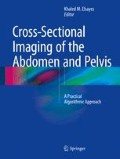Abstract
The peritoneum is a remarkably simple yet complex organ. Its choreographed folds and reflections resulting in ligaments, mesenteries, omenta, and cavities house and sustain the many vital organs and structures of the abdomen and pelvis. However, abnormal pathologic processes can also usurp the building blocks of the peritoneum. For example, the peritoneum can be thickened due to metastasis, primary peritoneal tumors, infection, and inflammation. Solid and cystic masses invading and distorting the omenta and mesenteries can be due to a variety of causes, such as omental infarction, carcinoid, desmoid, lymphoma, and metastasis. Abnormal peritoneal fluid collections such as ascites and mucin, furthermore, can distend the peritoneal cavity. Calcifications, intraperitoneal air, peritoneal defects, and foreign bodies are other abnormalities that claim the peritoneum.
Access this chapter
Tax calculation will be finalised at checkout
Purchases are for personal use only
References
Levy AD, Arnaiz J, Shaw JC, Sobin LH. From the archives of the AFIP: primary peritoneal tumors: imaging features with pathologic correlation. Radiographics. 2008;28(2):583–607; quiz 621-582.
Levy AD, Shaw JC, Sobin LH. Secondary tumors and tumorlike lesions of the peritoneal cavity: imaging features with pathologic correlation. Radiographics. 2009;29(2):347–73.
Low RN, Sebrechts CP, Barone RM, Muller W. Diffusion-weighted MRI of peritoneal tumors: comparison with conventional MRI and surgical and histopathologic findings–a feasibility study. AJR Am J Roentgenol. 2009;193(2):461–70.
Smiti S, Rajagopal K. CT mimics of peritoneal carcinomatosis. Indian J Radiol Imaging. 2010;20(1):58–62.
Corciulo R. Peritoneal dialysis: a time-limited therapy because of encapsulating peritoneal sclerosis? No, but due attention is warranted. G Ital Nefrol. 2010;27(5):448–55.
Singh AK, Gervais DA, Hahn PF, Sagar P, Mueller PR, Novelline RA. Acute epiploic appendagitis and its mimics. Radiographics. 2005;25(6):1521–34.
Pantongrag-Brown L, Buetow PC, Carr NJ, Lichtenstein JE, Buck JL. Calcification and fibrosis in mesenteric carcinoid tumor: CT findings and pathologic correlation. Am J Roentgenol. 1995;164(2):387–91.
Azizi L, Balu M, Belkacem A, Lewin M, Tubiana JM, Arrive L. MRI features of mesenteric desmoid tumors in familial adenomatous polyposis. AJR Am J Roentgenol. 2005;184(4):1128–35.
Elsayes KM, Broski SM, Makramalla A. Radiological reasoning: multiple mesenteric masses. AJR Am J Roentgenol. 2010;194(6 Suppl):S73–8.
Sheth S, Horton KM, Garland MR, Fishman EK. Mesenteric neoplasms: CT appearances of primary and secondary tumors and differential diagnosis. Radiographics. 2003;23(2):457–73.
Levy AD, Rimola J, Mehrotra AK, Sobin LH. Benign fibrous tumors and tumorlike lesions of the mesentery: radiologic-pathologic correlation. Radiographics. 2006;26(1):245–64.
Liu Y, Peng Y, Li J, Zeng J, Sun G, Gao P. MSCT manifestations with pathologic correlation of abdominal gastrointestinal tract and mesenteric tumor and tumor-like lesions in children: a single center experience. Eur J Radiol. 2010;75(3):293–300.
Pitta X, Andreadis E, Ekonomou A, et al. Benign multicystic peritoneal mesothelioma: a case report. J Med Case Reports. 2010;4:385.
Moyle PL, Kataoka MY, Nakai A, Takahata A, Reinhold C, Sala E. Nonovarian cystic lesions of the pelvis. Radiographics. 2010;30(4):921–38.
Cizginer S, Tatli S, Snyder E. CT and MR imaging features of a non-pancreatic pseudocyst of the mesentery. Eur J Gen Med. 2009;6(1):49–51.
Tsujimoto F, Miyamoto Y, Tada S. Differentiation of benign from malignant ascites by sonographic evaluation of gallbladder wall. Radiology. 1985;157(2):503–4.
Cohen JM, Weinreb JC, Maravilla KR. Fluid collections in the intraperitoneal and extraperitoneal spaces: comparison of MR and CT. Radiology. 1985;155(3):705–8.
Agarwal A, Yeh BM, Breiman RS, Qayyum A, Coakley FV. Peritoneal calcification: causes and distinguishing features on CT. Am J Roentgenol. 2004;182(2):441–5.
Teplick JG, Haskin ME, Alavi A. Calcified intraperitoneal metastases from ovarian carcinoma. AJR Am J Roentgenol. 1976;127(6):1003–6.
Chiu Y-H, Chen J-D, Tiu C-M, et al. Reappraisal of radiographic signs of pneumoperitoneum at emergency department. Am J Emerg Med. 2009;27(3):320–7.
Martin LC, Merkle EM, Thompson WM. Review of internal hernias: radiographic and clinical findings. AJR Am J Roentgenol. 2006;186(3):703–17.
Manzella A, Filho PB, Albuquerque E, Farias F, Kaercher J. Imaging of gossypibomas: pictorial review. Am J Roentgenol. 2009;193(6 Suppl):S94–101.
Lincourt AE, Harrell A, Cristiano J, Sechrist C, Kercher K, Heniford BT. Retained foreign bodies after surgery. J Surg Res. 2007;138(2):170–4.
Author information
Authors and Affiliations
Corresponding author
Editor information
Editors and Affiliations
Rights and permissions
Copyright information
© 2015 Springer Science+Business Media New York
About this chapter
Cite this chapter
Le, O., Elsayes, K.M. (2015). The Peritoneum. In: Elsayes, K.M. (eds) Cross-Sectional Imaging of the Abdomen and Pelvis. Springer, New York, NY. https://doi.org/10.1007/978-1-4939-1884-3_16
Download citation
DOI: https://doi.org/10.1007/978-1-4939-1884-3_16
Published:
Publisher Name: Springer, New York, NY
Print ISBN: 978-1-4939-1883-6
Online ISBN: 978-1-4939-1884-3
eBook Packages: MedicineMedicine (R0)

